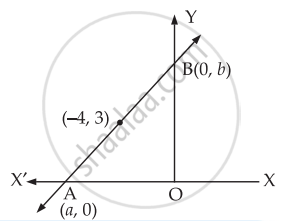Advertisements
Advertisements
Question
Find the equation of the line which passes through the point (– 4, 3) and the portion of the line intercepted between the axes is divided internally in the ratio 5 : 3 by this point.
Solution
Let AB be a line passing through a point (– 4, 3) and meets x-axis at A(a, 0) and y-axis at B(0, b).
∴ – 4 = `(5 xx 0 + 3a)/(5 + 3)`
⇒ – 4 = `(3a)/8` .....`[(because "X" = (m_1x_2 + m_2x_1)/(m_1 + m_2)),("and" "Y" = (m_1y_2 + m_2y_1)/(m_1 + m_2))]`
⇒ 3a = – 32
∴ a = `(-32)/3`
And 3 = `(5.b + 3.0)/(5 + 3)`
⇒ 3 = `(5.b)/8`
⇒ 5b = 24
⇒ b = `24/5`
Intercept form of the line is
`x/((-32)/3) + y/(24/5)` = 1
⇒ `(-3x)/32 + (5y)/24` = 1
⇒ – 9x + 20y = 96
⇒ 9x – 20y + 96 = 0
Hence, the required equation is 9x – 20y + 96 = 0.
APPEARS IN
RELATED QUESTIONS
Find equation of the line parallel to the line 3x – 4y + 2 = 0 and passing through the point (–2, 3).
If p and q are the lengths of perpendiculars from the origin to the lines x cos θ – y sin θ = k cos 2θ and xsec θ+ y cosec θ = k, respectively, prove that p2 + 4q2 = k2.
Find equation of the line which is equidistant from parallel lines 9x + 6y – 7 = 0 and 3x + 2y + 6 = 0.
Find the equation of the line which intercepts a length 2 on the positive direction of the x-axis and is inclined at an angle of 135° with the positive direction of y-axis.
Find the equation of the right bisector of the line segment joining the points (3, 4) and (−1, 2).
For what values of a and b the intercepts cut off on the coordinate axes by the line ax + by + 8 = 0 are equal in length but opposite in signs to those cut off by the line 2x − 3y + 6 = 0 on the axes.
Find the equation of the line on which the length of the perpendicular segment from the origin to the line is 4 and the inclination of the perpendicular segment with the positive direction of x-axis is 30°.
Reduce the equation \[\sqrt{3}\] x + y + 2 = 0 to slope-intercept form and find slope and y-intercept;
Reduce the equation\[\sqrt{3}\] x + y + 2 = 0 to intercept form and find intercept on the axes.
Reduce the following equation to the normal form and find p and α in \[x + y + \sqrt{2} = 0\].
Reduce the following equation to the normal form and find p and α in \[x - y + 2\sqrt{2} = 0\].
Reduce the following equation to the normal form and find p and α in x − 3 = 0.
Reduce the lines 3 x − 4 y + 4 = 0 and 2 x + 4 y − 5 = 0 to the normal form and hence find which line is nearer to the origin.
Find the area of the triangle formed by the line y = m1 x + c1, y = m2 x + c2 and x = 0.
Find the area of the triangle formed by the line y = 0, x = 2 and x + 2y = 3.
Prove that the following sets of three lines are concurrent:
\[\frac{x}{a} + \frac{y}{b} = 1, \frac{x}{b} + \frac{y}{a} = 1\text { and } y = x .\]
Find the equation of the perpendicular bisector of the line joining the points (1, 3) and (3, 1).
Find the equation of the straight line perpendicular to 2x − 3y = 5 and cutting off an intercept 1 on the positive direction of the x-axis.
Find the equation of the right bisector of the line segment joining the points (a, b) and (a1, b1).
Find the image of the point (2, 1) with respect to the line mirror x + y − 5 = 0.
Write the coordinates of the orthocentre of the triangle formed by the lines x2 − y2 = 0 and x + 6y = 18.
Find the equation of the line where length of the perpendicular segment from the origin to the line is 4 and the inclination of the perpendicular segment with the positive direction of x-axis is 30°.
Prove that every straight line has an equation of the form Ax + By + C = 0, where A, B and C are constants.
The inclination of the line x – y + 3 = 0 with the positive direction of x-axis is ______.
A line passes through (2, 2) and is perpendicular to the line 3x + y = 3. Its y-intercept is ______.
Locus of the mid-points of the portion of the line x sin θ + y cos θ = p intercepted between the axes is ______.
